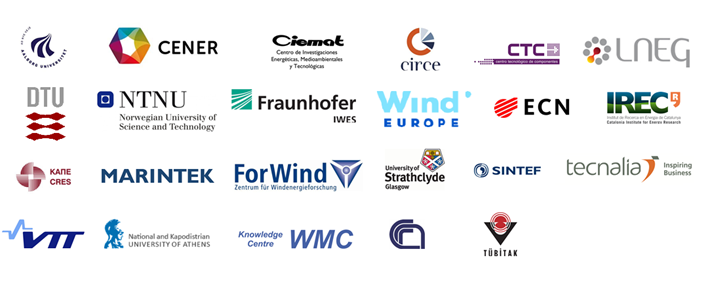This is the eight bi-annual newsletter for the EERA Joint Programme on Wind Energy (EERA JP WIND) after EERA JP WIND has successfully acquired the EU-funded IRPWIND project. Feel free to distribute the newsletter among your colleagues and friends!

Dear colleagues in EERA JP WIND and in IRPWIND
We are heading for the summer holidays in the coming months and so I would like to take this opportunity to outline some of the important activities that we currently have in EERA JP WIND and IRPWIND.
The third periodic review for IRPWIND was held in May and was an opportunity to outline what we have achieved and what are plans are for the coming year.
First and foremost, we are starting to look beyond IRPWIND, which ends in 2018. IRPWIND is currently funding a large part of the secretariat and coordination activities in our collaboration. We consequently need to look at how we wish to organise ourselves after IRPWIND.
IRPWIND is based on the idea that we could help strengthen national alignment by working with national funding agencies to create better synergies between national and EU research funding. That has not worked. As presented at the latest Steering Committee meeting in Copenhagen, March 29 2017, we are consequently moving our focus from national alignment to institutional alignment: two, three or more organisations agreeing to work on specific topics to use synergies from national projects. This is an area where I see a real opportunity for EERA JP WIND in the future.
Another important activity is our collaboration with the European wind energy industry to help shape the research and innovation agenda through ETIPWIND. EERA JP WIND represents the public research organisations and universities with 8 out of 24 seats in the ETIPWIND Steering committee and we have had a good collaboration with our colleagues from the industry.
As part of IRPWIND, we have drafted a business plan for EERA JP WIND 2.0. This was discussed at our latest EERA JP WIND SC meeting. In autumn, we will start the work of fleshing out the plan and start the implementation. I hope that the new EERA JP WIND 2.0 will be more transparent and leaner so that we can work on the strategic and scientific collaboration, which is at the heart of EERA JP WIND.
In IRPWIND we have also started a set of new activities on Open data and data management. You can read more about this initiative elsewhere in the newsletter, but I want to just highlight it here since it is an area where the entire EERA JP WIND Steering Committee has agreed to focus our attention.
Earlier this year, we launched the database EuropeanWind Projects.EU. I really hope that everyone will contribute to the this to help complete the mapping of publicly funded projects at both national and EU level that EERA JP WIND members participate in. Our industrial partners in the European Technology and Innovation Platform for Wind Energy (ETIPWIND) and the European Commission sees a great potential in having an overview of research activities in Europe.
We have also started the preparations of a new EERA JP WIND web site, which will be launched in 2018.
Looking at our Joint Programme, it should be highlighted that our pilot initiative on Cold Climate wind energy research has started. The initiative is led by Ville Lehtomäki from VTT.
Peter Hauge Madsen, DTU
Mattias Andersson, DTU

Ayman Attya, UoS & Jose Luis Dominguez-Garcia, IREC conducted research on the modification of frequency support markets to accommodate high wind penetration. This was in the context of Ayman Mobility stay at IREC. It yielded an accepted paper in the upcoming IEEE International Conference on Innovative Smart Grid Technologies (IEEE ISGT Europe 2017) in Torino. The paper is entitled ‘Estimation of frequency support market indices using Monte Carlo simulation for wind power generation’, it is expected to be available on IEEEXplore by the end of the year.
Ayman Attya, UoS & Jose Luis Dominguez-Garcia, IREC are organizing a special session in the context of the upcoming IEEE International Conference on Clean Electrical Power (ICCEP 2017) in Genoa. The special session is entitled ‘Ancillary services provision to ensure stability and security in future power systems’. Conference scientific programme can be found on www.iccep.net
Ayman Attya, UoS & Lluís Trilla, IREC conducted preliminary laboratory tests on the provision of frequency support by wind turbines. IREC remarkable testing facility hosted the tests, where a 5 kW variable speed wind turbine emulator was integrated. These tests could be an initial step for the joint experiment proposal that was submitted to WP2-Infrastructure programme earlier this year.
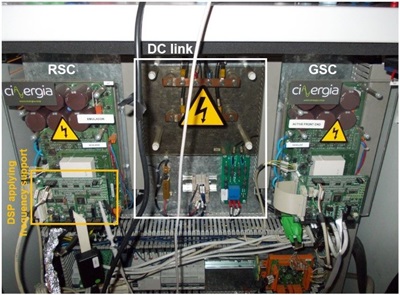
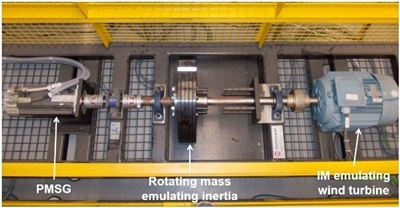

ScanFlow performs unique wind turbine inflow measurements for better modelling tools.
Wind turbines are being designed based on models predicting yield and loading. These models are as good as the data with which they are validated. Therefore, a higher accuracy of reference wind measurements will result in more accurate models, and thus better wind turbines. Within the ScanFlow project, ECN and DTU have very accurately measured the wind turbine inflow wind field measure of an ECN research wind turbine with various DTU scanning LiDARs in the framework of the IRPWIND’s first call for joint experiments.
Testing facilities
The measurement campaign was executed at the ECN Wind turbine Test site Wieringermeer early 2017. Among others, the test site comprises a row of five of ECN’s 2.5MW research turbines, accompanied with a meteorological mast. The research turbine at the utmost right in the picture below is the turbine under test.
|
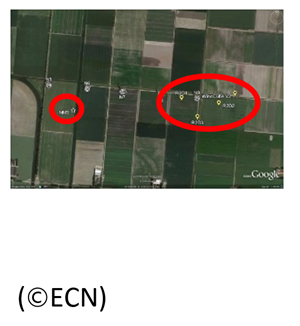
|
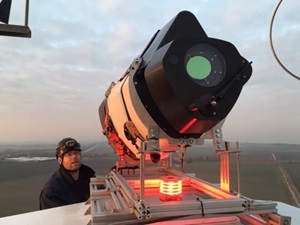
|
The inflow wind field of the turbine is primarily measured with a DTU SpinnerLidar and three DTU short range scanners. The SpinnerLidar is mounted on the nacelle of the turbine. It scans the wind field about 0.8 rotor diameters in front the turbine, taking a two-dimensional snapshot of the wind. The three short-range scanners are LiDARs placed on the ground that are programmed and synchronized such that they all measure at the same point in space and time. Therefore, they are able to capture the full three-dimensional aspects of the wind field. Also, they are focused such that they scan the same volume of air as the SpinnerLidar. Furthermore, a ground-based profiling LiDAR captures the undisturbed wind conditions while a meteorological mast registers atmospheric conditions, providing essential background information for the model validation.
Unique, public dataset
This unique, highly detailed and comprehensive dataset is now available to the research community via the ScanFlow website.

To address the issue of R&I market uptake and to increase synergies between the wind research and industry communities the IRPWIND project set up an information corner in the conference Area of the Offshore Wind Energy 2017 conference & exhibition in June. At the information booth the IRPWIND team presented the IP Showcase to the entire wind energy community and hosted a matchmaking session. In this session the participating Technology Transfer Experts presented some available IP’s and discussed market uptake opportunities with the industry representatives.
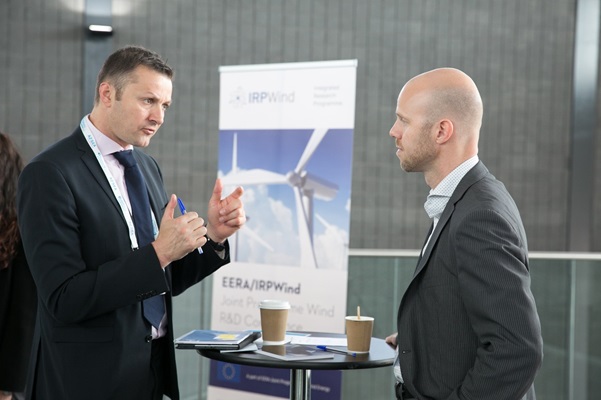

The poster "Step-wise stochastic optimisation of transmission grid for offshore wind farm clusters" by Harald G Svendsen, Martin Kristiansen and Magnus Korpås received a poster award at the Offshore Wind Energy 2017 conference in London on 7 June 2017. The poster describes a new method for optimising offshore grid layout taking into account investment costs, generation costs, variability in wind resources, the benefit of trade between price areas, as well as uncertainties in future developments. Recent improvements in the optimisation approach makes it easier to identify robust offshore grid investments.
The poster is based on work related to IRPWIND Task 8.3, funded by IRPWIND and the Norwegian Research Centre for Offshore Wind Technology (NOWITECH). Details have been reported in the project deliverable D83.6.
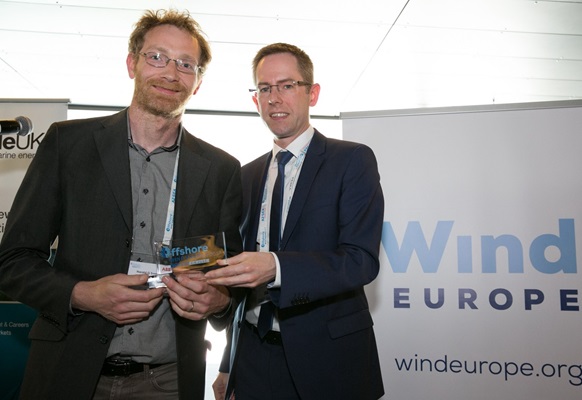
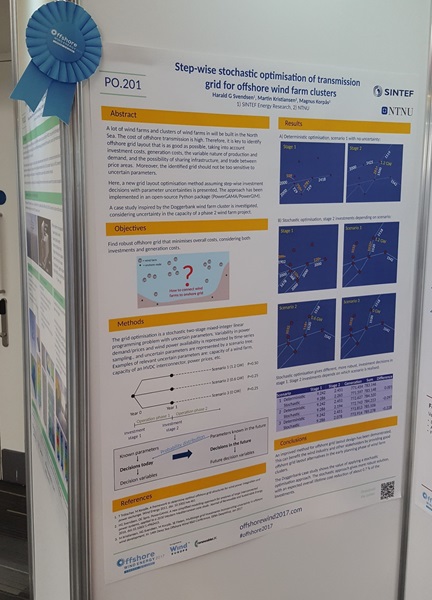

At the 12th EERA JP WIND Steering Committee Meeting November 17 2016 in Brussels, three new EERA JP WIND applicants were approved to become members of EERA JP WIND. The new members are:
- University of Uppsala, Sweden
- Barcelona Super Computing Center, Spain
- Cranfield University, United Kingdom
University of Uppsala had applied to become a full member for which they were approved. University of Uppsala will in the future be having a seat in the Steering Committee, represented by Stefan Ivanell.
Barcelona Super Computing Center and Cranfield University had both applied for being associate members. Cranfield University was approved for this conditioned being members of the EERA AISBL. The EERA ExCo approved them as members in March 2017. BSC was approved by the EERA JP WIND SC to enter as an associate member of EERA JP WIND for a one-year period after which their contribution will be assessed. The membership was as for Cranfield conditioned that they entered the EERA AISBL. The were approved by the EERA ExCo meeting in March 2017.
BSC primary contact is Arnau Folch Duran.
Crandfield University’s primary contact is Maurizio Collu.
EERA JP WIND warmly welcomes all three new members and is looking forward to cooperate.

The deputies for the Subprogramme Coordinator for the SP of Wind Condition and the SP on Aerodynamics have been replaced during the last months. Further the EERA JP WIND has established a new pilot initiative on Cold Climate driven by VTT. Please for information find below an updated list of all subprogramme coordinators and their deputies:
|
Subprogramme
|
Coordinator
|
Deputy
|
|
SP1: Wind Conditions
|
Hans Ejsing Jørgensen (DTU Wind Energy)
|
Jake Badger (DTU Wind Energy)
|
|
SP2: Aerodynamics
|
Peter J. Eecen (ECN)
|
Jan Willem Wagenaar (ECN)
|
|
SP3: Structures and Materials
|
Arno van Wingerde (Fraunhofer IWES)
|
Anastasios Vasilopoulos (EFPL)
|
|
SP4: Offshore Wind
|
John Olav Tande (SINTEF)
|
Hans Christian Bolsted (SINTEF)
|
|
SP5: Grid Integration
|
Kurt Rohrig (Fraunhofer IWES)
|
Michael Durstewitz (Fraunhofer IWES)
|
|
SP6: Research Facilities
|
Antonio Ugarte (CENER)
|
Xabier Munduate (CENER)
|
|
SP7: Wind integration, social and economic aspects
|
Klaus Skytte (DTU Management)
|
Poul Erik Morthorst (DTU Management)
|
|
Pilot initiative Cold Climate
|
Ville Lethomäki (VTT)
|
|

Get informed and be prepared for the next calls for Free-of-Charge transnational access to marine research Infrastructure!
Marine Renewable Infrastructure Network for Enhancing Technologies 2 — MARINET2 — is a Marine Renewables Infrastructure Network of 39 organizations amongst the top leaders in the sector.
It is a €10.5M EU project aiming to accelerate the development of wave, tidal and offshore wind energy technologies and infrastructure by opening up access to 57 test facilities across 13 European countries, on a yearly call base.
- Access costs to both infrastructure and expertise are paid by the H2020
- All scales facilities are available, from lab to sea
- Open to companies of any size, research groups etc.
Call for application for Free-of-Charge transnational access to infrastructures are issued once per year, the first call has been in May 2017, the second call will be in January 2018. So be prepared by getting informed at http://www.marinet2.eu/
PROJECT OVERVIEW
Integrating activities planned under MaRINET 2 build upon the achievements of the advanced community created in MaRINET FP7.
MaRINET 2 will ensure the continued integration and enhancement of all leading European research infrastructure and facilities specialising in research, development and testing of offshore renewable energy systems including electrical sub systems and grid integration through a range of TRLs (1-7).
MaRINET FP7 proved the added value of uniting these facilities and identified critical areas for further technical investigation and enhancement.
Whilst activities proposed under MaRINET 2 will follow the same formula, balancing networking/ joint research/ and transnational access, the consortium and scope of work is expanded to include 39 partners in 13 countries with 57 facilities.
DTU leads the Work Package 6 E-infrastructures. This is an important new element that fills a strategic gap offering access to data and virtual services. Taking stock of existing capacities for data management/sharing; it addresses user requirements and demonstrates the operation of a new system based on standards and tools adapted from the SeaDataNet infrastructure www.seadatanet.org .
The European Commission and member states recognize offshore renewable energy as an important source of clean energy that can: generate economic growth and employment; increase energy security; and boost competitiveness and technological innovation.
The realisation of this potential depends on the accelerated development, deployment and grid integration of reliable, efficient technologies for harvesting offshore renewable energy, which in turn requires robust and exhaustive testing in dedicated facilities operated by practitioners with specialised expertise.
MaRINET 2 provides this ecosystem, and is pre-eminently suited to fostering the next generation of offshore renewable energy devices.

|
31st of August 2017
Ultimate chance to apply for a mobility grant
|

|
This news is directed to the several people that have expressed the interest in this unique opportunity to visit and collaborate with colleagues in other institutions.
The feedback from the questionnaires shows that all “mobilised” colleagues have been satisfied by their choice and we even had cases of a second submission. So, do not miss this last chance!
After the 31st of August 2017, the call will only be open for managers, including IRPWIND Management Board, Work Package leaders, the IRPWIND Management Board members and the EERA JP WIND Energy Steering Committee members for periods up to 2 weeks.

Storm or calm, dark clouds or blue skies - wind turbines and photovoltaic systems supply more or less energy to the grid depending on weather conditions. A big challenge for transmission grid operators is having to forecast the amount of supplied energy as accurately as possible in order to maintain a stable grid. Fraunhofer IWES in Kassel, together with the German Meteorological Service (DWD) in Offenbach, has thus developed mathematical models as part of the EWeLiNE project, which enables significantly improved predictions than the traditional procedure. The partners have now completed the BMWi sponsored project which started at the end 2012.
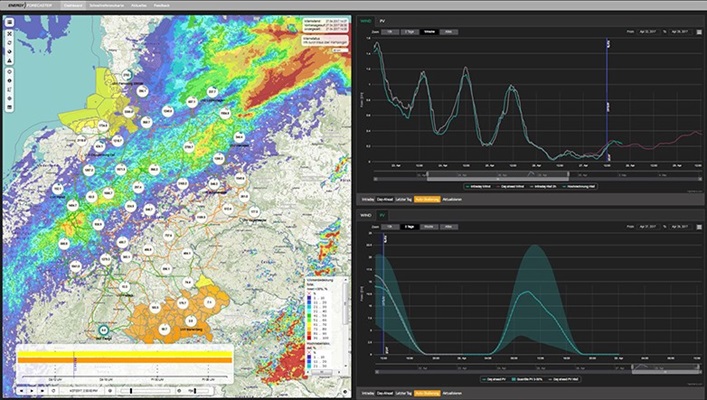

On Tuesday 20 June 2017, the Steering Committee of the ETIPWind (the European Technology and Innovation Platform for Wind energy) met at the WindEurope office in Brussels for its second quarterly meeting. During this meeting the Steering Committee discussed recent R&I policy developments, such as the status of the new H2020 work programme for 2018-2019-2020 and the Innovation Fund. In addition, they also held a workshop on digitalisation in the wind industry.
During this workshop, which focused on cost reduction and system integration, the Steering Committee divided into two groups to discuss the R&I priorities needed to prepare the wind industry for the expected digitalisation of the energy sector. The first group was comprised of both turbine and components manufacturers and the second group included the representatives of utilities and developers. The EERA representatives were able to join the group of their choosing. The outcomes of the workshop will be valuable messaging tools to influence the upcoming funding programmes and will also be used as input for the upcoming IEA publication on Digitalization and Energy.
On 21 June 2017, the ETIPWind Advisory Group came to Belgium for a plant visit to the ZF Wind Power plant in Lommel and a high level policy discussion with Christopher Jones, Deputy Director General of DG ENER, in Brussels. The meeting with Mr. Jones provided a forum for the CTO’s of some of the leading wind energy companies to directly present the industry’s R&I priorities to the highest echelons of the European Commission.
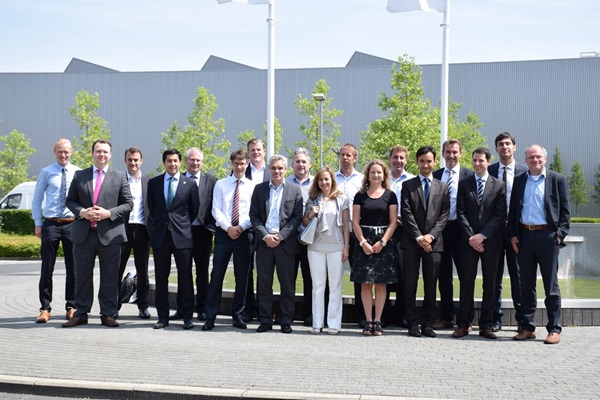

On Tuesday 20 June 2017, the ETIPWind also held an event on how wind energy contributes to the EU’s sustainable energy goals and on how ETIPWind is supporting efforts to scale up that contribution. The event stressed that sustained R&I support is a key trigger to unlock the growth potential of wind and other renewable energy. Over 55 people attended the ETIPWind event and the corresponding networking reception. Presentations by Mike Anderson (RES) and Mattias Andersson (DTU) highlighted the fascinating history the wind industry as well as its contribution to the EU energy transition. Furthermore there were presentations on two pf the most critical R&I priorities for the wind energy sector. Adrian Timbus (ABB) spoke about Energy Management Systems and why they can bring both significant cost reduction to the industry and help reach the EU’s objectives of clean and efficient energy and Lars landberg (DNV GL) highlighted how big data, data analytics & machine learning will revolutionise the O&M of wind turbines and farms. To conclude the event, there was a open panel discussion with the keynote speakers and Mark Van Stiphout (Deputy Head of Unit Research and Innovation, DG ENER, European Commission) and a networking reception in collaboration with the LeanWind project.
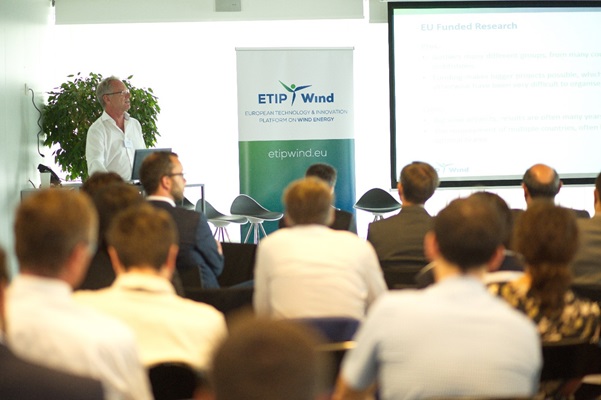

The European Academy of Wind Energy had its Wind Energy Scientific Conference 2017 hosted at DTU from 26 to 29 June 2017 in Denmark. Four days of presentations, networking, knowledge sharing and the ultimate definition of factual fun for all wind geeks.
The wind industry is ultimately driven by research, delivering inventive well-trained applied brain power. That is why we in the European Technology and Innovation Platform for Wind Energy (ETIPWIND) recently decided to give our official stamp of recognition to this and other high-quality conferences organised by the research communities in EERA JP WIND and EAWE.
This EAWE conference has created a place of nurture for upcoming ideas and talent, helping young/old scientists/engineers alike test the waters for their idea to change the face of wind power going forward.
The conference was also a welcome break for wind professionals, from their daily work, allowing them to revisit the taste of the academic fervor, to understand, control and improve the delightful resource of wind while catching up with old and making new buddies. A new not to miss event for anybody serious about wind energy - which delivered a steady breeze of new ideas that will become assimilated in our minds during our summer break. A sincere thank you all for sharing and DTU for hosting. #contentedwithwind
Aidan Cronin, Chair ETIPWind.
The European Technology and Innovation Platform on Wind Energy (ETIPWind) connects Europe’s wind energy community. The objective is to define concrete research and innovation (R&I) priorities and communicate these to the European institutions and other decision making bodies. ETIPWind advises policy makers in a systematic and coordinated way, facilitating collaboration and sharing information with all wind energy stakeholders.

Are you involved as an engineer, technician, planner, researcher, trader, consultant, regulator, teacher or student in the offshore wind energy business? Do you want to get a comprehensive overview and hands-on experience about the burning issues and the current status of offshore wind energy research? Then you should have a look at the new book »Sea - Wind - Power«. The editors are Michael Durstewitz and Bernhard Lange, two researchers from Fraunhofer IWES who have organized and coordinated the RAVE research activities in Alpha Ventus for more than a decade. The authors of »Sea - Wind - Power« are RAVE project leaders from academia, authorities and industry. The book reports on the objectives, methods used and difficulties faced by the RAVE research projects. It presents the results and their significance for the future use of offshore wind energy in a style that is understandable for everyone.
ISBN: 978-662-53178-5
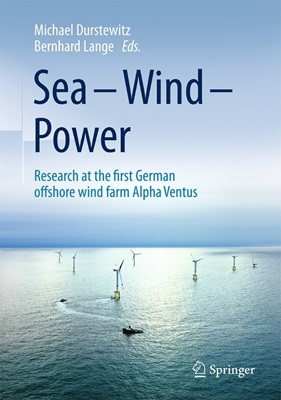

Once again I have the privilege to invite you to the annual IRPWIND Conference in Amsterdam, organised by EERA JP WIND. The 2 day event aims for knowledge dissemination as well as creating further alignment between industry, the research community and policy makers.
This year the event will take place on the 25th and 26th of September, in the trusted Aristo accommodations. It will be the final conference organised under the IRPWIND umbrella. All the more reason to look forward. This edition will look beyond current plans, beyond 2025. The confirmed speakers will shed a light on what their vision is on the future of offshore wind energy. With TenneT, Ampyx, Blauwwind, Hywind and 10MW+ turbines being presented, the content will be very interesting for both the research community, industry and the policy makers that will be attending.
Like the previous editions, the programme will consist of parallel workshops, interspersed with plenary presentations. The first day will be closed with a poster session and evening programme including dinner. If you have received an invitation already, you are kindly asked to register and submit a short abstract for a poster presentation, if applicable.
If you are interested in attending the conference, but have not received an invitation, please contact the organisation through: irpwindconf@ecn.nl. There are limited seats available.
Martijn van Roermund, ECN

As part of the IRPWIND project, EERA JP WIND is developing a comprehensive taxonomy as well as a search portal to help make wind energy research data findable and accessible. The core group includes DTU, CENER, ECN, ForWind and SINTEF, Join us at the IRPWIND conference in Amsterdam this September for an interactive session to create better access to needed data.
Despite the general acknowledgement for Open Data, as the way to fast innovation, there is still a mindset in a way similar to ‘not-in-my-backyard’ that holds back sectorial scientific and industrial communities to implement a joint Open Data policy. One of the major issues is the fear that the different types of sensitive and proprietary data would be e.g. openly distributed and even worse, misused. To address this challenge, the European Commission has included the data management plan as mandatory to all H2020 projects declaring at the same time, that data must be Findable, Accessible, Interoperable and Re-usable (FAIR) and as much open as possible, and as close as necessary.
The EERA JP WIND Energy, as the largest public European scientific community in the wind energy sector, has widely recognized the necessity of implementing an open data strategy. As part of the FP7 project IRPWIND, we have taken a first step toward the design of an open data strategy for the sector.
The overall goal of the IRPWIND (and EERA JP WIND) initiative on open data is to create and demonstrate a web portal where to search and locate cloud distributed data relevant for wind energy.
The first phase relates to making data “Findable” in a web search. To allow a search engine to easily locate data, datasets must be tagged i.e. described by associating a series of information “Metadata” to data. Metadata is information about what (associated topic, variable) where (geographical location) data were collected or where they are stored, when, how long, who, format, access rights etc.
To help end-users refine the search for relevant data, we also need a form of thematic classification and organization of data, i.e. Taxonomy, to put data into a thematic context. Taxonomy elements are a descriptive type of metadata answering to the “what “question. A good taxonomy enables users to immediately grasp the overall structure of the knowledge domain and the associated data.
There are two interesting uses of taxonomy: the first is to organize and find data, as described above, - the second is to organize a sector activity in a hierarchy of topics and subtopics from the main general term e.g. Wind Energy, to subtopics down to the smallest details. An easy example is the internal organization of a department in thematic sections covering the whole sector. This allows keeping track of development in different areas of a sector, mapping cross fertilization and single out niches that might be merged to produce innovation. This second use will be the subject of a future development.
In the IRPWIND task, a number of taxonomies have been created for the WE topics and for tagging data, allowing a faceted search.
At the IRPWIND annual Conference in Amsterdam, 25-26 September, the road to a first taxonomy conceptual scheme and to the design of a data portal will be presented in a poster and an interactive specific tailored session. Join the group!!
If you want to know more please contact Anna Maria Sempreviva or Nikola Vasiljevic - DTU Wind Energy

